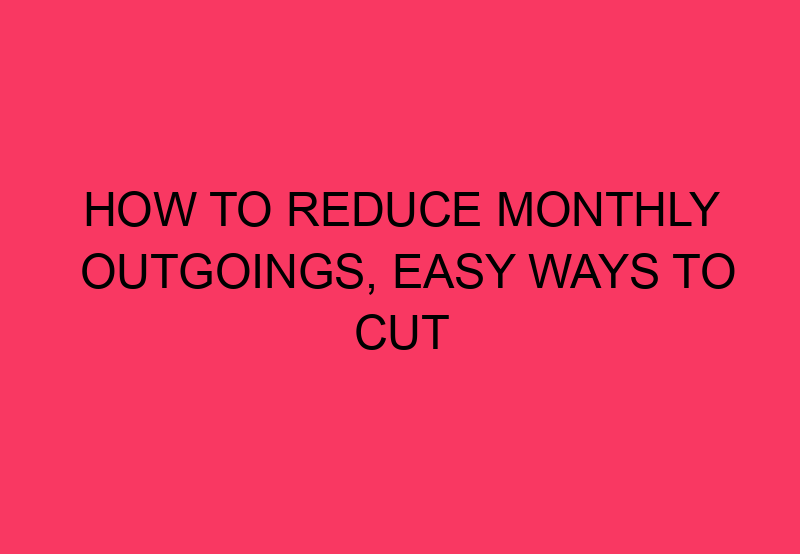How to create a monthly budget is covered in detail on our Budgeting and Money Management page. It outlines the steps you should take to determine your monthly income, necessary and desired expenditures, and savings goals. In a perfect world, this would free up some money each month for you to spend on things that aren’t necessities. so, how to reduce monthly outgoings?
Of course, we don’t live in a perfect world. In many cases, monthly expenses exceed income. The two choices you face in this scenario are as follows. You may either increase your income or decrease your expenses.
The first of these two choices is discussed on this page, along with some suggestions on how to prioritize your financial outlays.
Power comes from knowledge.
It’s human nature to want to disregard the fact that your expenses exceed your income if that’s the case. After all, acting as though everything is OK is much simpler.
On the other hand, in this circumstance, information is quite potent, as it allows you to take action once you become aware of the issue.
Finding where and how to save costs involves a few different procedures how to reduce monthly outgoings.
-
Having a firm grasp of the current situation
Finding out how much money you make and how much money you spend on various things is the first step.
Take several weeks, or at least a full month, to keep track of your income and expenses. One can use a simple notepad or account book, a spreadsheet, or one of the numerous accessible applications for managing one’s finances.
All of your normal monthly expenses should be accounted for in this way, including your mortgage or rent, insurance, and the costs of running your home, including your phone, internet, and cable. Take into account, like you would with a budget, any yearly expenses you incur. Yet another of each of them should be accounted for in your monthly budget.
-
Sort Your Expenditures By Category
Next, you’ll want to divide your spending between necessities and luxuries, or requirements and desires.
Items that are essential to your survival or professional success cannot be compromised. Things like food, shelter, transportation to and from work, and home heating and cooling systems fall into this category. Clothing, especially business attire, is also acceptable to include. But you also need to be practical.
The need for garments should be obvious. Instead, you may try a secondhand store or a wholesale club.
One definition of an essential budget item is the ability to replace outgrown children’s clothing. Possessing the latest and greatest in designer attire and accessories, or even just getting a fresh wardrobe every month, may be quite desirable.
Having access to regular food is crucial. However, you may pack lunches from the grocery and eat them at work every day. Going out to lunch with coworkers or friends, or even just buying lunch at the fancy pizza place down the street, may be appealing.
Sub-categories such as “generally important but the cost might be decreased” or “essential, but not necessary in this form” are therefore worth exploring.
-
Look for Plain Areas to Cut Back on.
Search for clear places where you might be able to save costs as your third step, how to reduce monthly outgoings
These will consist of:
spending that is solely motivated by want, such as buying that usual espresso on the way to work, those amazing shoes you got for a great deal, or your streaming subscription. This category consists mostly of nice-to-have items that wouldn’t make the world end if you didn’t have them.
Spending money on non-essential products while spending money on essentials, such as buying more costly clothing or lunches at work. This expenditure will consist of both one-time and recurring expenses. For instance, you can be paying for a large automobile when a much smaller, less expensive one would suffice.
-
Spending Your Financial Reserves
You must now calculate the value of your financial reserves. How much money will you save every month as a result of each adjustment?
You must ground yourself in reality at this time. If you want to pack a lunch every day, for instance, you’ll need to allocate more money to the grocery store. Since you’re not careful with your purchases, this can rapidly become a significant sum. Find out how much it actually cost by doing some investigating. Overconfidence will get in the way.
When these cost-cutting measures will be implemented should also be specified. Don’t expect the savings from switching your phone plan in a year to be instantly available. To begin, tally the most immediate cost-savings and then specify when the remaining savings will kick in.
-
Checking to See if Cash Flow Is an Issue Is an Added Bonus Step
The final How To Reduce Monthly Outgoings. Consider whether your problem is one of cash flow rather than one of mismanagement of your income and expenditures.
There may be enough cash coming in to pay your costs, but it will arrive at the wrong moment.
There are occasions during the month when you may become overdrawn despite having more money entering into your account than going out. This can occur if your income is not consistently scheduled but your outgoing payments are, such as through direct deposits or standing orders. The issue is not exclusive to freelancers; some companies pay on the final Friday of each month rather than a set day of the month.
